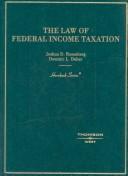| Listing 1 - 7 of 7 |
Sort by
|
Book
Year: 1997 Publisher: Cambridge, Mass. National Bureau of Economic Research
Abstract | Keywords | Export | Availability | Bookmark
 Loading...
Loading...Choose an application
- Reference Manager
- EndNote
- RefWorks (Direct export to RefWorks)

ISBN: 9780314161338 Year: 2008 Publisher: Saint Paul Thomson West
Abstract | Keywords | Export | Availability | Bookmark
 Loading...
Loading...Choose an application
- Reference Manager
- EndNote
- RefWorks (Direct export to RefWorks)
Digital
Year: 1995 Publisher: Cambridge, Mass. National Bureau of Economic Research
Abstract | Keywords | Export | Availability | Bookmark
 Loading...
Loading...Choose an application
- Reference Manager
- EndNote
- RefWorks (Direct export to RefWorks)
Digital
Year: 1997 Publisher: Cambridge, Mass. National Bureau of Economic Research
Abstract | Keywords | Export | Availability | Bookmark
 Loading...
Loading...Choose an application
- Reference Manager
- EndNote
- RefWorks (Direct export to RefWorks)
Book
Year: 1994 Publisher: Cambridge, Mass. National Bureau of Economic Research
Abstract | Keywords | Export | Availability | Bookmark
 Loading...
Loading...Choose an application
- Reference Manager
- EndNote
- RefWorks (Direct export to RefWorks)
This paper develops a methodology for testing the term structure of volatility forecasts derived from stochastic volatility models, and implements it to analyze models of S&P 500 index volatility. Volatility models are compared by their ability to hedge options positions sensitive to the term structure of volatility. Overall, the most effective hedge is a Black-Scholes (BS) delta-gamma hedge, while the BS delta-vega hedge is the least effective. The most successful volatility hedge is GARCH components delta-gamma, suggesting that the GARCH components estimate of the term structure of volatility is most accurate. The success of the BS delta-gamma hedge may be due to mispricing in the options market over the sample period.
Stochastic processes. --- Heteroscedasticity. --- Hedging (Finance)
Book
Year: 1995 Publisher: Cambridge, Mass. National Bureau of Economic Research
Abstract | Keywords | Export | Availability | Bookmark
 Loading...
Loading...Choose an application
- Reference Manager
- EndNote
- RefWorks (Direct export to RefWorks)
This paper addresses the issue of hedging option positions when the underlying asset exhibits stochastic volatility. By parameterizing the volatility process as GARCH, and utilizing risk- neutral valuation, we estimate hedging parameters (delta and gamma) using Monte-Carlo simulation. We estimate hedging parameters for options on the Standard and Poor's 500 index, a bond futures index, a weighted foreign exchange rate index, and an oil futures index. We find that Black-Scholes and GARCH deltas are similar for all the options considered, while GARCH gammas are significantly higher than BS gammas for all options. For near the money options, GARCH gamma hedge ratios are higher than BS hedge ratios when hedging a long term option with a short term option. Away from the money, GARCH gamma hedge ratios are lower than BS.
Book
Year: 1997 Publisher: Cambridge, Mass. National Bureau of Economic Research
Abstract | Keywords | Export | Availability | Bookmark
 Loading...
Loading...Choose an application
- Reference Manager
- EndNote
- RefWorks (Direct export to RefWorks)
This paper develops a method for option hedging which is consistent with time-varying preferences and probabilities. The preferences are expressed in the form of an empirical pricing kernel (EPK), which measures the state price per unit probability, while probabilities are derived from an estimated stochastic volatility model of the form GARCH components with leverage. State prices are estimated using the flexible risk-neutral density method of Rosenberg (1995) and a daily cross-section of option premia. Time-varying preferences over states are linked to a dynamic model of the underlying price to obtain a one-day ahead forecast of derivative price distributions and minimum variance hedge ratios. Empirical results suggest that risk aversion over S&P500 return states is substantially higher than risk aversion implied by Black-Scholes state prices and probabilities using long run estimates of S&P500 return moments. It is also found that the daily level of risk aversion is strongly positively autocorrelated, negatively correlated with S&P500 price changes,and positively correlated with the spread between implied and objective volatilities. Hedging results reveal that typical hedging techniques for out-of-the-money S&P500 index options, such as Black-Scholes or historical minimum variance hedging, are inferior to the EPK hedging method. Thus, time-varying preferences and probabilities appear to be an important factor in the day-to-day pricing of S&P500 options.
| Listing 1 - 7 of 7 |
Sort by
|

 Search
Search Feedback
Feedback About UniCat
About UniCat  Help
Help News
News